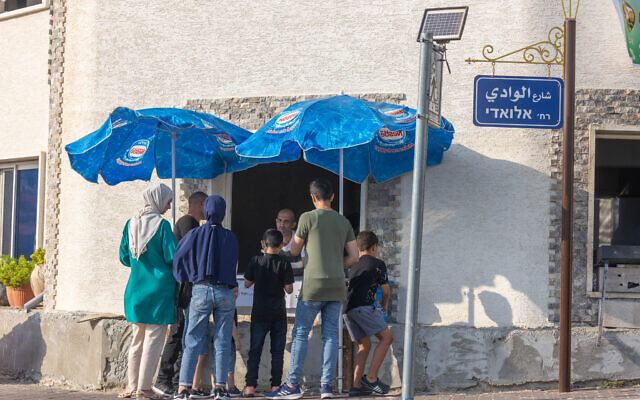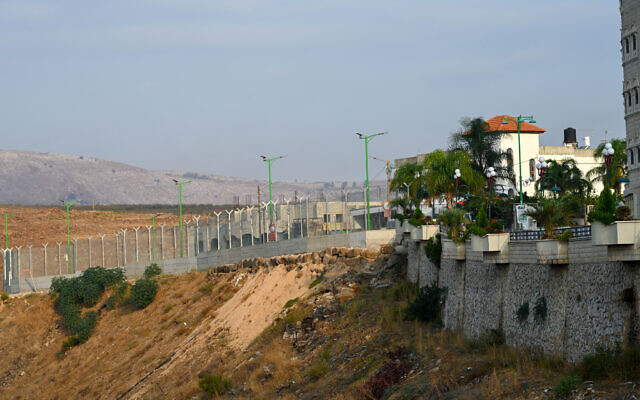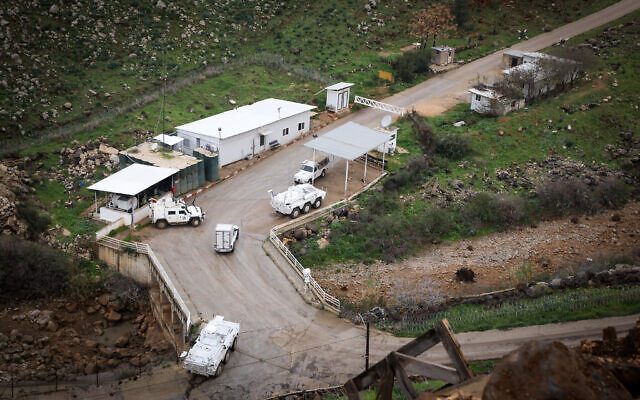GHAJAR (JTA) – A group of 40 tourists filed into Khateb Sweets on a recent Sunday afternoon, bringing chatter — and their cash and credit cards — to what had been a quiet cafe in this equally sedate village in the Golan Heights.
They left after consuming pastries and hot tea spiced with ginger, anise and cinnamon, whereupon an Jewish Israeli couple came in, then an Arab Israeli family and three Canadians.
The steady foot traffic typifies the wave of tourists that since last fall has hit this community of 2,900 people, nearly all Alawites, an Islamic sect.
Ghajar (pronounced RA-zhar) had for decades been unusually cut off from the rest of Israel. Residents could come and go, but outsiders could visit only through prior arrangement with the Israel Defense Forces, which considered the village within a closed military area where Lebanon and Israel’s Galilee and Golan Heights regions intersect.
The IDF’s lifting of the restriction without explanation on September 8 led to an immediate rush of visitors eager to explore Ghajar.
How immediate? Ahmad Khateb, a pastry chef who owns the eponymous cafe, was working that day at his consultancy job at a hotel in the Galilee town of Safed, when his employee called to report an unusual stream of tourists entering the shop. The following morning, Khateb resigned to work at his café full time.
Approximately 4,000 people visited Ghajar the day the town opened, he said. Another 6,000 visited the following day — briefly tripling the number of people in town. For day three, a Saturday, Ghajar turned a soccer field into a parking lot.

People visit the Arab village of Ghajar, located between Lebanon and Israel in northern Israel, October 14, 2022. (Yossi Aloni/Flash90)
“It’s like a gift that fell from the sky,” Khateb said of the village’s opening and his subsequent increase in sales. He’s now considering expansion to other locations.
Ghajar possesses a Forbidden City-like attraction for Israelis, who travel extensively inside their own country because it generally requires a flight to visit others.
“You know why we came here? Because there aren’t a lot of places [in Israel] we haven’t been,” said Shmuel Browns, a Jerusalem-based tour guide accompanying his brother and sister-in-law visiting from his native Toronto. “We wanted to get a sense of what makes this village unique.”
It is also notable as the only Israeli community of Alawites, a Syria-based ethnic minority best known as the group that the country’s dictatorial rulers for the past 52 years — current president Bashar Assad and his late father, Hafez — are descended from. Bilal Khatib, who is Ghajar’s accountant and spokesman, said Alawites tend to be secular people who value a person’s character and are respectful of other Muslim sects and different religions. Ghajar contains no mosques, since, except on holy days, people pray individually at home.
“It’s a way of life,” Khatib said. “We respect people as people. Our religion is to be a good person, love everyone and hold no hatred against anyone, be they Druze, Jew, Christian or Circassian.”
But most unusual is Ghajar’s provenance, on which outsiders tend to stumble. “Ghajar was part of Lebanon, right?” the Israeli couple at the cafe asked Khateb.
No, he responded.
So began a short primer that residents are wont to recite to visitors — a timeline of a village of just one-fifth of a square mile. (The fields on Ghajar’s outskirts constitute an additional five square miles, on which the village plans to expand.)

View of the border fence between Lebanon and Israel as it seen from the Arab village of Ghajar, in northern Israel, September 7, 2022. (Michael Giladi/Flash90)
Israel captured the Golan Heights, including Ghajar, from Syria during 1967’s Six Day War and officially annexed it in 1981. After Israel ended its 18-year war in Lebanon in 2000, the United Nations certified the IDF’s withdrawal and established the two countries’ border going through, rather than around, Ghajar. Israel later announced plans to withdraw below the UN line. That would have split the village into northern and southern sections. Residents protested, preferring to remain under Israeli sovereignty rather than be divided. Ultimately, Israel didn’t erect a barrier inside the village.
“It’s a headache,” Jamal Khatib, a physical education teacher at the village’s lone high school, said of the chronology.
Orna Mizrahi, an analyst at the Tel Aviv-based Institute for National Security Studies, agrees with that characterization. As a member of the National Security Council, she briefed then-prime minister Ariel Sharon on Ghajar at what proved to be his last cabinet meeting hours before he suffered a debilitating and ultimately fatal stroke in 2006.
As to why the IDF recently opened the town, Mizrahi cited the completion of a security fence around Ghajar, along with the lessened threat of cross-border attacks by the Hezbollah terrorist organization, due in large part to the recent maritime border agreement between Israel and Lebanon that incentivizes the government in Beirut to restrain Hezbollah.
“The security considerations are different. The situation in Lebanon is different,” she said.
Exactly why the United Nations associated the town with Lebanon, even though most of its residents are from a Syrian sect, is a point of confusion for many who visit. A 1965 Syrian map that Bilal Khatib printed offers an explanation: It shows Ghajar as an enclave completely inside Lebanon except for a narrow sliver connecting it to Syria proper.
Bilal Khatib (he, Jamal Khatib and Ahmad Khateb are unrelated) lives in the northern section and said he would not want his sister, who lives south of the UN’s 2000 demarcation, to be inaccessible.
The UN’s dividing point, known as the Blue Line, would be “splitting families,” he said. “We have to be united.” In practice, this line exists only on maps and has no impact on the life of Ghajar residents, who are fully under Israeli rule.

People visit the Arab village of Ghajar, located between Lebanon and Israel in northern Israel, October 14, 2022. (Yossi Aloni/Flash90)
Ghajar residents tend to see themselves as Syrians holding Israeli citizenship. It’s a high-achieving population: According to Jamal Khatib, 400 Ghajar residents hold a college degree, making the town far more educated, on average, than Arab Israelis overall. He said there are 50 physicians, 30 lawyers, 27 dentists and two professors, most commuting to jobs in the Galilee. Until Syria’s civil war began in 2011, Ghajar residents legally crossed at nearby Kuneitra to attend Syrian universities, he said.
“There’s no profession in Israel that’s not represented here,” he said.
Politically, Ghajar stands out for supporting mostly Jewish-majority parties. In the recent election, Benny Gantz’s centrist party got 24% of the 555 citizens who went to the polls in the village. The Arab party Ra’am got only 14% of the votes and the rest went to other Jewish slates, including the ultra-Orthodox Shas party.
Ghajar puts a premium on livability. Fountains, parks and outdoor sculptures abound, landscaping and building façades are colorful and nary a speck of litter is evident. Homes are large and well-kept, on par with other upscale areas in Israel. Motorcycles and the honking of vehicles’ horns are prohibited. Visitors may not enter between 8 p.m. and 8 a.m., Jamal Khatib said, adding that Ghajar has long banned hotels and bed-and-breakfast inns and does not plan to change the rules in response to the flood of visitors.
Some visitors have littered and urinated in public, and even entered residents’ homes without knocking, he said.
“A year ago, you wouldn’t have seen that,” said his son, Ryad, who works as Ghajar’s coordinator of volunteers, including handling traffic control on days when tourists abound.

View of the Arab village of Ghajar, on the border with Lebanon, in northern Israel, January 13, 2023. (Issac Harari/Flash90)
Unlike many small towns in Israel, Ghajar operates its own sanitation service rather than linking up with other municipalities through a regional council. Doing so is an unusual expenditure, but it’s one that means visitors to the town may see Ghajar’s name on a garbage truck — a potentially powerful symbol.
“We’re doing it not for you, but for ourselves,” Jamal Khatib said of the village’s quality-of-life values. “I like that people come, but they should respect the rules, respect our privacy.”
For its part, Ghajar projects respect for the wider society. Street signs and storefronts appear in Hebrew and Arabic. The Park of Peace includes a statue of the Virgin Mary, a sculpture of an open Koran, an Alawite sword symbol and a menorah.
“You and I believe in one God,” Jamal Khatib said. “Your deeds speak as to who you are.”
From his back porch a few moments later, a donkey’s braying could be clearly heard, hundreds of sheep observed and calls to prayer drifted over from a mosque – all in Aarab el Louaizeh, a village in Lebanon perhaps 100 yards away.

UN peacekeepers (UNIFIL) on the Border between Lebanon and Israel as it seen from the Arab village of Ghajar, in northern Israel, January 13, 2023. (Issac Harari/Flash90)
In a ravine below, soldiers of the United Nations and the Lebanese army in their separate posts walked outside. The UN soldiers entered two vehicles and began their twice-daily patrol of the border. Alongside the border road is the Hatzbani River, where Khatib fished as a young man. At his property line, a separate fence on Ghajar’s northern perimeter is nearly complete.
But the fence wasn’t erected to divide people or demarcate boundaries: It’s to keep boars, jackals and porcupines from scaling the slope and entering the village, Khatib said. He soon received an alert on his phone.
“The notification says there are cows on the road,” he explained. “It’s dark. Be careful.”
"entry" - Google News
January 30, 2023 at 07:48AM
https://ift.tt/Kx4U3ra
Entry restrictions lifted, isolated village on Lebanon border is now tourist hotspot - The Times of Israel
"entry" - Google News
https://ift.tt/ix2t0vG
https://ift.tt/UrQTLOJ
Bagikan Berita Ini














0 Response to "Entry restrictions lifted, isolated village on Lebanon border is now tourist hotspot - The Times of Israel"
Post a Comment